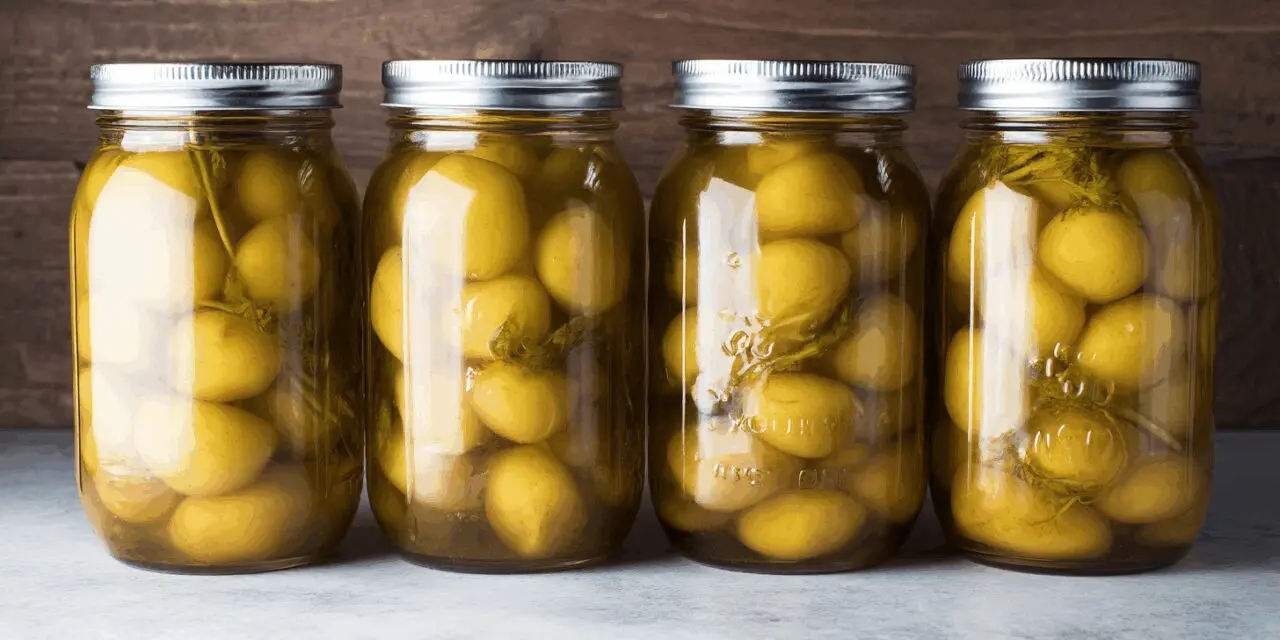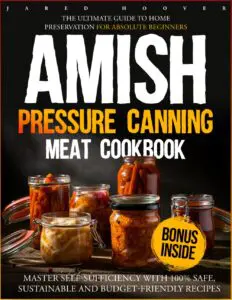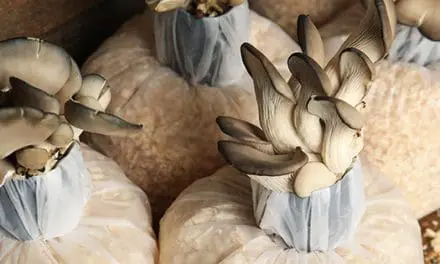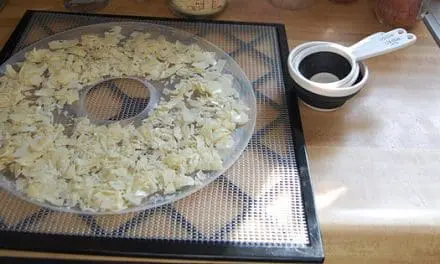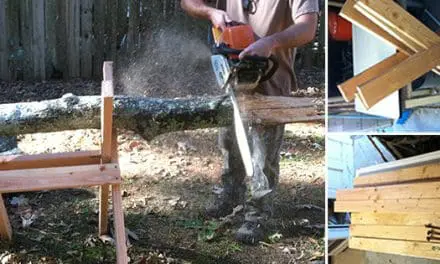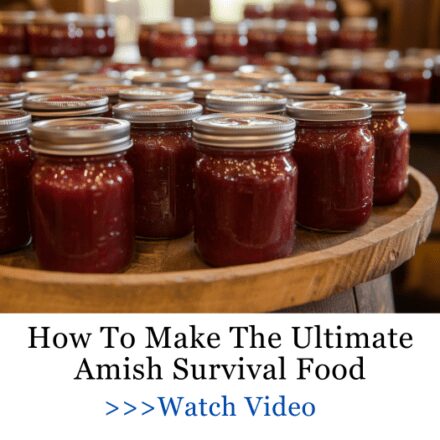When you’re striving for true self-sufficiency, a well-stocked pantry is more than just convenience – it’s security. Canning potatoes is one of the most practical ways to preserve a staple crop for long-term storage, making them available at a moment’s notice. Whether you’re looking to preserve your garden harvest or take advantage of a seasonal sale, knowing how to can potatoes the right way ensures you have hearty, nourishing food on hand year-round. We talked about how long potatoes last in the past but it is time to take it one step further.
In this guide, we’ll walk you through the best types of potatoes to can, cover whether or not dry canning is safe, go over sweet potatoes, and share a reliable, time-tested pressure canning recipe you can count on.
Why Pressure Canning Potatoes Is the Only Safe Method
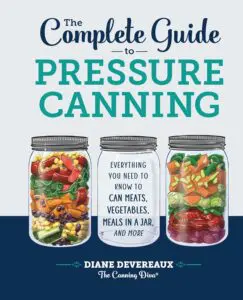 First things first: potatoes are a low-acid food, which means they must be pressure canned. Water bath canning simply doesn’t get hot enough to kill the bacteria that cause botulism. Pressure canning reaches the necessary temperature of 240°F (116°C) or higher, making it the only method that ensures safety.
First things first: potatoes are a low-acid food, which means they must be pressure canned. Water bath canning simply doesn’t get hot enough to kill the bacteria that cause botulism. Pressure canning reaches the necessary temperature of 240°F (116°C) or higher, making it the only method that ensures safety.
Is Dry Canning Potatoes Safe?
You may have seen videos or blog posts promoting “dry canning” potatoes—either putting raw potatoes directly into jars without liquid or placing jars in an oven. This method is not recommended and is considered unsafe by reputable food preservation sources like the USDA and the National Center for Home Food Preservation.
Dry canning doesn’t allow heat to penetrate evenly, especially to the center of the jars, which increases the risk of botulism. Always pressure can potatoes with liquid to ensure heat is distributed properly.
Best Potatoes for Canning
Not all potatoes are created equal when it comes to canning. Waxy potatoes like Red, Yukon Gold, or New Potatoes hold their shape well and are less likely to become mushy. These varieties have a lower starch content, making them ideal for canning.
Avoid high-starch varieties like Russets. While they’re great for baking or mashing, they tend to fall apart during the canning process and can create cloudy jars and a gummy texture.
Top picks for canning:
- Red potatoes
- Yukon Gold
- Kennebec
- Fingerling potatoes (if cut to size)
Can You Can Sweet Potatoes?
Yes, sweet potatoes can be pressure canned, but the process is slightly different from canning white or yellow potatoes. Sweet potatoes must be cooked before canning, as they are too dense to be canned raw safely.
How to Can Sweet Potatoes:
- Scrub, peel, and cut sweet potatoes into uniform pieces.
- Boil until partially tender (about 10–15 minutes).
- Pack hot into jars, add boiling water (leaving 1-inch headspace), and pressure can.
Pressure Canning Time for Sweet Potatoes:
- Pints: 65 minutes at 10 PSI
- Quarts: 90 minutes at 10 PSI
Adjust pressure for altitude as needed.
Canning Potatoes Recipe (Step-by-Step Instructions)
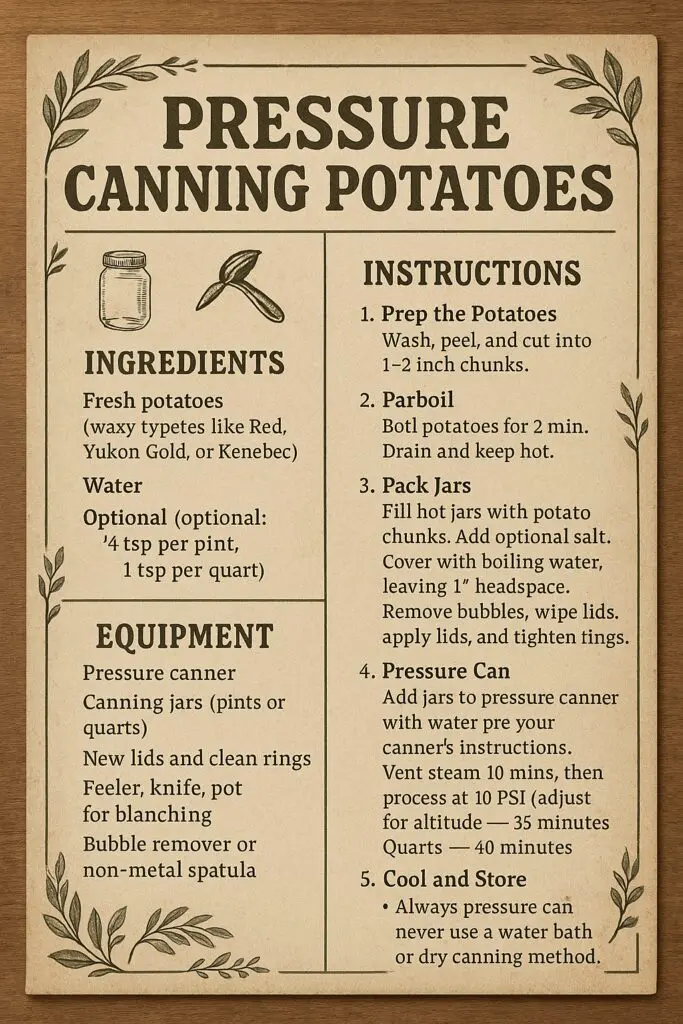
Ingredients:
- Fresh potatoes (waxy varieties preferred)
- Water
- Optional: Salt (½ tsp per pint, 1 tsp per quart)
Equipment:
- Pressure canner
- Canning jars (pints or quarts)
- New lids and clean rings
- Peeler, knife, and pot for blanching
 Step 1: Prepare the Potatoes
Step 1: Prepare the Potatoes
- Wash and peel potatoes. Peeling is mandatory to ensure safety during canning.
- Cut into 1–2 inch cubes. Uniformity helps them cook evenly.
Step 2: Parboil the Potatoes
- Boil potato chunks for 2 minutes in a large pot. This removes surface starch and ensures even heat penetration.
- Drain and keep hot while preparing jars.
Step 3: Pack the Jars
- Fill hot jars with potato chunks.
- Add optional salt.
- Pour in boiling water, leaving 1 inch of headspace.
- Remove air bubbles with a plastic spatula or bubble remover.
- Wipe rims clean, apply lids, and tighten rings to fingertip tightness.
Step 4: Pressure Can
- Place jars in your pressure canner with 2–3 inches of water (per your canner’s instructions).
- Lock the lid and vent steam for 10 minutes before applying weight or closing the vent.
- Process at 10 PSI:
- Pints: 35 minutes
- Quarts: 40 minutes
Note: If you live above 1,000 feet elevation, adjust pressure according to your canner’s manual—typically 15 PSI at higher elevations.
Step 5: Cool and Store
- Turn off heat and let pressure return to zero naturally.
- Remove jars and place on a towel. Let sit undisturbed for 12–24 hours.
- Check seals. Store sealed jars in a cool, dark place for up to a year.
Final Thoughts on Canning Potatoes
Canning potatoes is an excellent way to build food security and get the most from your harvest. It may take some time upfront, but the convenience of having ready-to-use potatoes that require no peeling or chopping later on is well worth it. Just remember: pressure canning is the only safe method. Skip any shortcut methods that claim otherwise.
Whether you’re prepping for winter, powering through a homestead surplus, or simply building your self-reliant pantry one jar at a time, pressure canning potatoes is a tried-and-true method that deserves a spot in your food preservation playbook.
How Long Do Potatoes Last in the Fridge Cooked?
This Is What You Should Store In Your Root Cellar (Video)
Why You Should Cure Potatoes Before You Store Them for Winter

